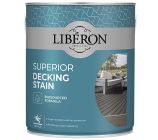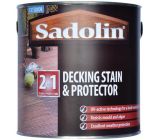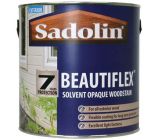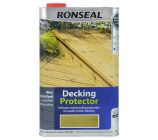
Decking Stain
-

Liberon Superior Decking Stain
From:£23.95(inc VAT)multiple sizes -

Johnstone's Decking Stain
From:£35.49(inc VAT)multiple sizes -

Sadolin Decking Stain & Protector
From:£0.00(inc VAT) -

Sadolin Beautiflex Solvent Opaque Woodstain
From:£17.95(inc VAT)3 colours multiple sizes -

Ronseal Decking Protector
From:£41.49(inc VAT) -

Liberon Anti-Slip Coating
From:£19.95(inc VAT)multiple sizes -

Cuprinol Anti-Slip Decking Stain
From:£17.49(inc VAT)multiple sizes
Should I use decking oil or stain?
The first question to ask before staining your deck is whether you should be using decking oil or stain. Decking oil is a preventative measure that helps to protect the wood over time; decking stain, on the other hand, provides some protection but also enhances the appearance of decking by colouring it. Use stain if you want to alter the colour of your decking and oil if not.
When should you stain your decking?
After your decking has been installed, you should wait four to eight weeks and allow the deck to dry out thoroughly before you stain it for the first time. Every two to three years after this, you should clean, prepare, and re-stain the surface to maintain your decking.
How many coats of stain on a deck?
As a general rule of thumb, you should apply two coats of stain to your decking each time you restain it. If the decking is still patchy after two coats, try adding one more (be careful not to overcoat the wood, though).
How much stain do I need for my decking?
Of course, the amount of stain you need depends on the size of your decking and the type of stain you plan to use. Firstly, measure the area that you want to stain on your decking in m2. Once you’ve worked this out, refer to the specific product instructions for your preferred decking stain.
For example, one litre of Cuprinol Anti-Slip Decking Stain covers 12m2 and we are applying two coats, so you would need at least 6.7 litres of stain for a 40 m2 area of decking. Given that it’s always best to have a little extra to ensure you achieve full coverage, you should buy 7.5 litres of Cuprinol Anti-Slip in this case (one 5-litre and one 2.5-litre tin).
What happens if you stain a deck and it rains?
If it rains on your recently stained deck, the outcome will depend on how long the stain has had to dry. Should it rain as soon as you’ve finished the staining process, the stain will likely begin to peel and may flake off in areas (and will need to be stained again). With some time for the stain to dry partially, rainfall may create blotches in the finish but you may not need to stain the deck again.
How to stain decking?
To stain decking to a professional standard, you’ll need a pressure washer, a broom, a scrubbing brush, decking cleaner, a paintbrush, decking stain, and a belt sander with 80-grit sandpaper. Follow these instruction to stain your deck:
- Wait until there are several days of clear weather forecasted with low chance of rain throughout (the process takes two to three days in total).
- Using your belt sander, sand down any splintered areas of the decking and sweep away any debris.
- Pressure wash the surface of your decking, then use the scrubbing brush and decking cleaner to clean the deck thoroughly.
- Leave the decking to dry out completely before continuing; this may take one to two days, depending on the weather.
- Once the deck is dried out, prepare the surrounding area by taping over any adjoining areas that could come into contact with the decking stain then sweeping the surface clean.
- Stir your decking stain and apply it to raised features such as railings using your paint brush – use long, even strokes as if you were painting a wall.
- Before moving on to stain the floor, plan your exit carefully and work towards that area. For example, apply from the outside in and move towards your back door, using long brushstrokes again throughout.
- Once you’re finished, leave the stain to dry out completely for around 24 hours, then repeat the process if required (usually two coats produces the best results).
How to remove decking stain?
When reconditioning old decking, you may have to remove the old, flaking stain away before you can restrain the surface. To remove decking stain, you’ll need a stiff brush, decking stripper, gloves, a paint brush or roller, and a pressure washer. Follow these steps to remove decking stain completely:
- As with staining a deck, wait for a few clear days, with no rain, and temperatures of between 10°C and 25°C (the optimum conditions for stripping a deck).
- Wearing your gloves, shake the stripper solution, pour it out into a plastic container, then stir it through using a paint brush.
- Divide the area of the decking up into sections of two or three boards that you can complete in under 10 minutes.
- Apply the stripper to the first of these sections in the same way as you paint walls, using long, even strokes. Do not walk on a section that has stripper on it.
- Making sure to leave a section free to walk on, apply a thin coat of stripper to the remaining areas.
- Apply a second coat to each section of decking roughly an hour after the first coat was applied.
- An hour after the second coating has been applied, test out a small area by scrubbing it thoroughly with a scrubbing brush – ensure that the stain has been removed effectively.
- If the stain has not been removed from the test section, apply a further coat to the deck.
- Wait for an hour and then scrub the entire deck with your scrubbing brush, followed by a thorough pressure wash to wash away all of the residue.
- Allow at least two days of drying time before staining the deck.







